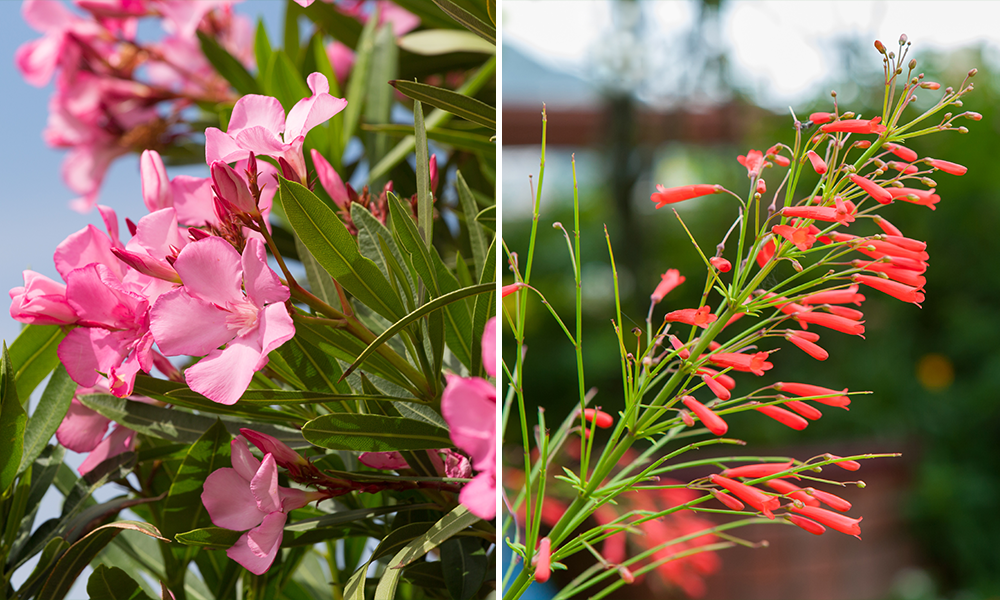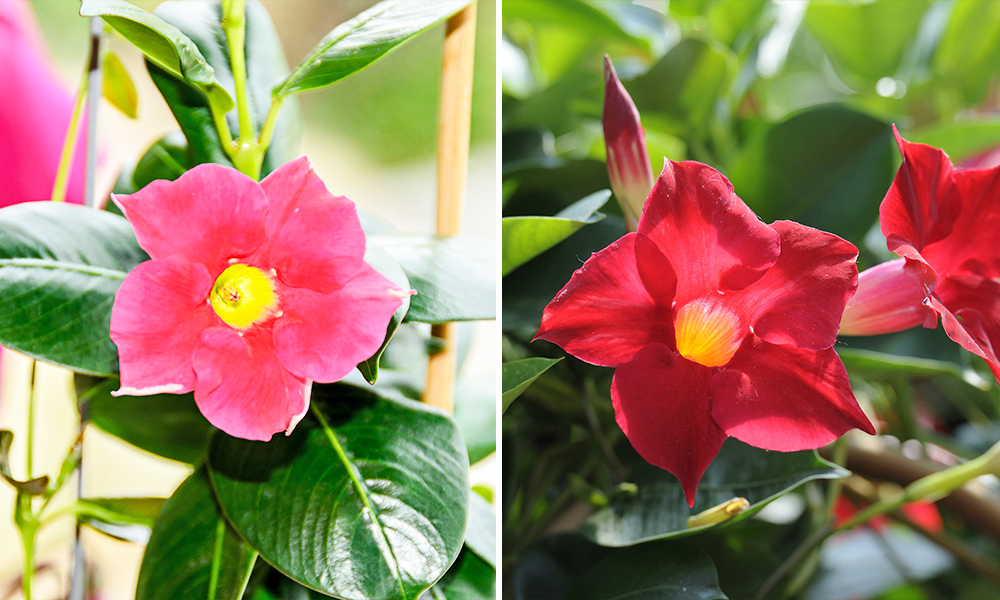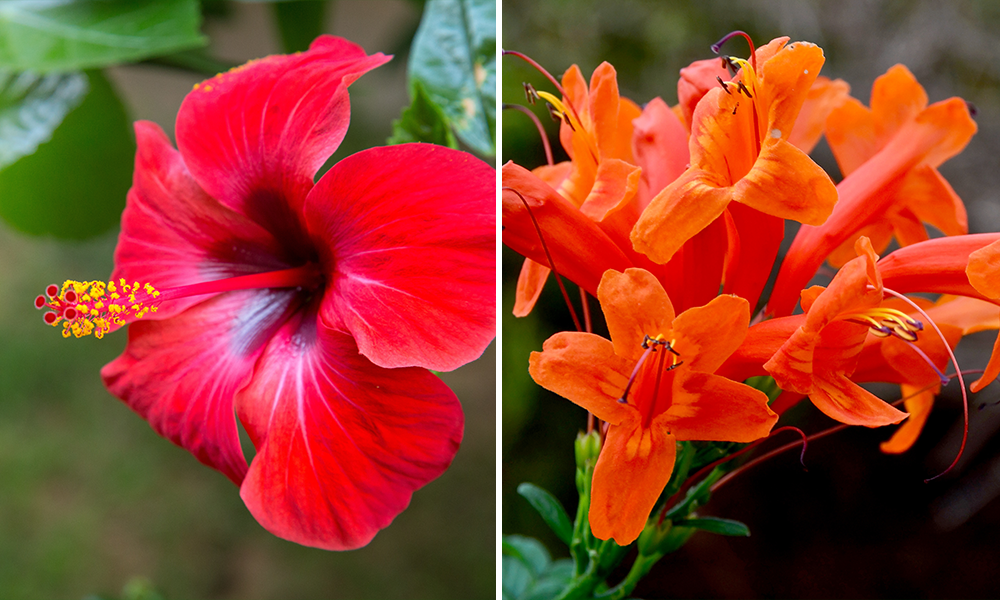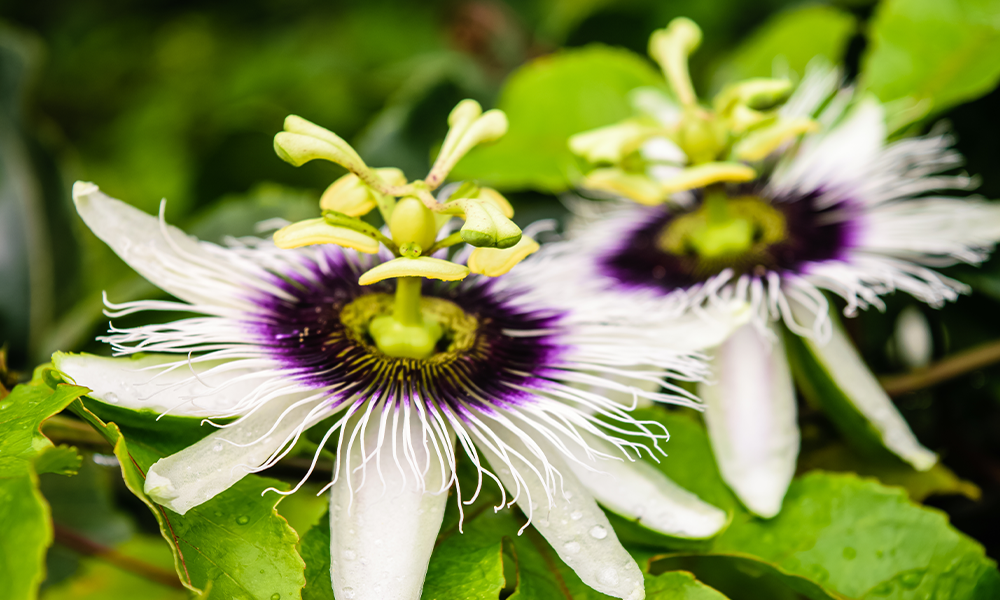The daily work grind often has us dreaming of packing up for a tropical destination with exotic flowering plants around every corner. Instead of yearning for a trek across the world, why not bring that exotic island-paradise vibe to your own backyard? Having your own outdoor home retreat, complete with vibrant tropical blossoms in a spectrum of fabulous colors, will help make every weekend feel like a staycation.
Tropical Flowering Plants For The Landscape
Check out these 7 stunning outdoor tropical plants that you can grow at home in your garden. Their exotic, eye-catching blossoms will have you craving piña coladas and humming “La Bamba” on repeat!
Oleander Bush: This graceful evergreen beauty features slim, elegant foliage and graceful upright branches, all topped with gorgeous aromatic flowers. The waxy blooms come in several shades of pink that are easy to match to most color palettes. Drought- and heat-tolerant, oleander bush attracts butterflies and hummingbirds anywhere you place it—which could be just about anywhere. Oleander is perfect for borders, backgrounds, accent or specimen planting, hedging or screening, and even as a container plant—pretty, and practical!
Oleanders are very easy to grow and can survive most conditions—except weather under 20 ̊F. The only major downside to oleander bush is it is known to be toxic when ingested. If young children or curious animals spend any time in your garden, you may want to opt for a different plant on this list.

Fire Cracker Bush: This dramatic plant has no shortage of personality! An excellent blooming groundcover, fire cracker bush features a shock of foliage that quite literally resembles the fireworks on the fourth of July. It’s neon-colored tubular flowers add to the “explosion” effect while reigning in hummingbirds!
Fire cracker bush is fairly resilient, and can come back from some pretty tough conditions. Hardy to 20 ̊F, a little frost will hurt it, but not kill it. Similarly, a little drought will make it look worse for wear but the plant will revive quickly with a good drink. The plant performs best in full sun, with an application of slow-release fertilizer (included with your purchase) at the beginning of spring.
Mandevilla Flower: We love the pink pinwheel-shaped blossoms on this flowering vine, commonly grown on patio trellises. If you live in an area where the temperature doesn’t dip below 38 ̊F, your mandevilla can stay outside all year, but if things start to get chilly around wintertime, it’s best if you bring it back indoors until spring. Be sure to check for any unwanted pests on the undersides of its leaves before bringing it inside! Dappled, partial sunlight is best for the mandevilla, because intense, direct sunlight may cause scorching.
When planting, enrich the soil with the included bag of slow-release fertilizer. Re-apply more slow-release fertilizer every 3 months. Pinch back mandevilla stems in early summer to help your plant develop more blooms and a nice, bushy shape. Our mandevillas love full sun, but they also perform beautifully on the west-facing side of the house where the sun hits them in the late afternoon.

Dipladenia Bush: It’s clear to see why so many tropical lovers adore dipladenia, a close relative of mandevilla. They come in a rainbow of colors, and their cheerful blossoms are as versatile as they are beautiful. As a climbing vine, dipladenia will happily beautify trellises, hanging baskets, container gardens, and just about any other spot in the garden that could use some drama. You can even keep dipladenia as a houseplant!
Since they’re so closely related, caring for dipladenia is virtually identical to mandevilla. Both are intolerant of frost. The key differences between the plants are the shape of the foliage as well as their habits. Dipladenia have smoother leaves than mandevillas, and their habit takes on more of a bush form whereas mandevillas tend to vine out. Hummingbirds and butterflies love them equally, so the preference is all yours!
Tropical Hibiscus: No tropical paradise garden would be complete without this classic flowering plant, with its bold, colorful blossoms in gorgeous shades of peach, orange, pink, or yellow. The tropical hibiscus can be easily grown in USDA zones 9 or higher.
Hibiscus aren’t just lovely to look at—they’re pretty tasty, too! Hibiscus petals are often brewed into delicious drinks and iced teas, so if you really want your backyard tropical retreat to come full circle, try concocting some hibiscus cocktails to sip on while you’re lounging around on the patio. Make sure your hibiscus gets plenty of sunshine and lots of water, and you’ll be rewarded with fabulous flowers with little effort on your end.

Cape Honeysuckle Bush: Loaded with clusters of tubular nectar-filled flowers, there’s no denying this bushy tropical is a favorite of hummingbirds and butterflies! With vining branches and zesty yellow-orange blooms, cape honeysuckle is great for brightening up a fence, showing off in containers, or as an attractive groundcover. Our cape honeysuckle plants bloom year-round to give your garden a constant dose of energizing color! Once you notice the flowers fading, pinch them off to start up a new bloom cycle.
Cape honeysuckle isn’t a challenging plant to grow, but it is particular about sun exposure and soil moisture. Be sure to plant yours in a spot with at least 6 hours of full sun, but keep the soil evenly moist. Clay, sandy, or loamy soils work best for cape honeysuckle, but above all, the soil must have good drainage.
Passion Vine: Passion vine’s extraordinary blossoms are unique and strangely beautiful. This climbing plant is quite a vigorous grower with large, three-lobed leaves that grasp onto the nearest surface and climb upward and out. They look spectacular on a trellis and do a fabulous job of attracting hummingbirds and butterflies to your garden.
The root systems of passion vine plants are vulnerable to pest damage and fungal infestations, so to make sure your passion vine is set off on a good trajectory for growth. Make sure you’re planting it in full sun with well-draining soil, loaded with organic matter or compost.

It’s incredible how the addition of beautiful, tropical flowering plants can completely transform a landscape, whisking you off to paradise every time you catch a glimpse of their vibrant colors. Tropical Plants of Florida is your go-to shop for the finest tropicals, fully grown and ready to plant—so you can skip the plane ticket and instantly achieve the backyard oasis you’ve always dreamed of. Like what you’re reading? Find out our Top 8 Tropical Plants for 2020.

